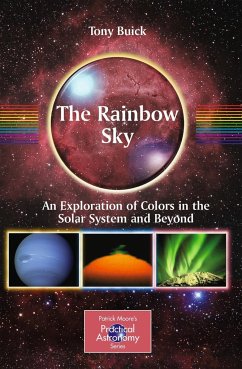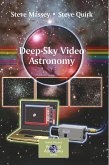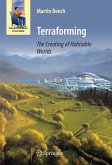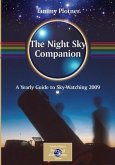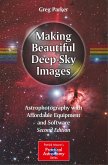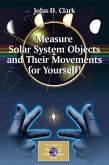There are numerous astronomical and meteorological phenomena involving color, many visible with the unaided eye or modest telescope. This reference details easy-to-follow techniques to see and photograph these phenomena. It includes over 300 photographs.
W here do you start to write about colors in the universe? Do you look to the deepest ocean trenches on Earth, with their awesome bioluminescent creatures roaming the blackness of the abyss? And where do you finish? With the most distant galaxies in the cosmos? A difficult question, p- haps, but in between the two extremes, there is so much to marvel at that it really doesn't matter where you start or end, as long as you note the staggeringly beautiful and complex examples of color there are and that each should, if possible, be represented in some way. Whether staring up at the sky when surprised by the sudden appearance of a vividly colored band of light that is a rainbow or peering through a telescope to view colors further afield, the origin and complexity of the source of light is witness to the wonderful and majestic world and the universe in which we live. A n attempt has been made here not only to create a picture gallery of the universe, but also to provide brief explanations or interpretation of the colors and, where appropriate, to give hints on how to capture p- tures easily yourself, without spending lots of money. As illustrated in the introduction, paying attention to just a few basic camera settings, it is possible to turn a blurred snapshot into a detailed and pin sharp picture worthy of framing and hanging on the wall.
W here do you start to write about colors in the universe? Do you look to the deepest ocean trenches on Earth, with their awesome bioluminescent creatures roaming the blackness of the abyss? And where do you finish? With the most distant galaxies in the cosmos? A difficult question, p- haps, but in between the two extremes, there is so much to marvel at that it really doesn't matter where you start or end, as long as you note the staggeringly beautiful and complex examples of color there are and that each should, if possible, be represented in some way. Whether staring up at the sky when surprised by the sudden appearance of a vividly colored band of light that is a rainbow or peering through a telescope to view colors further afield, the origin and complexity of the source of light is witness to the wonderful and majestic world and the universe in which we live. A n attempt has been made here not only to create a picture gallery of the universe, but also to provide brief explanations or interpretation of the colors and, where appropriate, to give hints on how to capture p- tures easily yourself, without spending lots of money. As illustrated in the introduction, paying attention to just a few basic camera settings, it is possible to turn a blurred snapshot into a detailed and pin sharp picture worthy of framing and hanging on the wall.
From the reviews:
"Fireworks, flames, fiery pink sunsets, and rainbows: the world is a burst of color. We take it for granted, but as Tony Buick argues in The Rainbow Sky, that is how it should be. Gray roses wouldn't tempt us to inhale their sweetness, and gray flames wouldn't warn us they are hot and dangerous. Color, as the author discusses, is necessary to interpret our world and its place in the cosmos. Through stunning imagery, personal commentary and a conversational tone, Buick takes readers on a journey to explore color and discover its origins, it peculiarities and its ability to inspire awe. The Rainbow Sky, in its conversational tone, explains color on Earth, in the Solar System and beyond, and it reminds of the beauty and science of the rainbow." -(Ashley Yeager, Public Information Officer, W. M. Keck Observatory)
"To interest an older child or a teenager in the beauty of astronomy and physics, this book, which is full of colored pictures, will work very nicely. ... Many of the photographs are beautiful, indeed, stunning. ... physics teacher may use it to illustrate some lectures on optics and gravitation. The faculty advisor of an astronomy club will definitively use the book to help the youngest members discover the beauty of the universe. ... also be a great Christmas present for a young aspiring astronomer." (Gary J. Long, Belgian Physical Society Magazine, Issue 1, 2011)
"Fireworks, flames, fiery pink sunsets, and rainbows: the world is a burst of color. We take it for granted, but as Tony Buick argues in The Rainbow Sky, that is how it should be. Gray roses wouldn't tempt us to inhale their sweetness, and gray flames wouldn't warn us they are hot and dangerous. Color, as the author discusses, is necessary to interpret our world and its place in the cosmos. Through stunning imagery, personal commentary and a conversational tone, Buick takes readers on a journey to explore color and discover its origins, it peculiarities and its ability to inspire awe. The Rainbow Sky, in its conversational tone, explains color on Earth, in the Solar System and beyond, and it reminds of the beauty and science of the rainbow." -(Ashley Yeager, Public Information Officer, W. M. Keck Observatory)
"To interest an older child or a teenager in the beauty of astronomy and physics, this book, which is full of colored pictures, will work very nicely. ... Many of the photographs are beautiful, indeed, stunning. ... physics teacher may use it to illustrate some lectures on optics and gravitation. The faculty advisor of an astronomy club will definitively use the book to help the youngest members discover the beauty of the universe. ... also be a great Christmas present for a young aspiring astronomer." (Gary J. Long, Belgian Physical Society Magazine, Issue 1, 2011)

